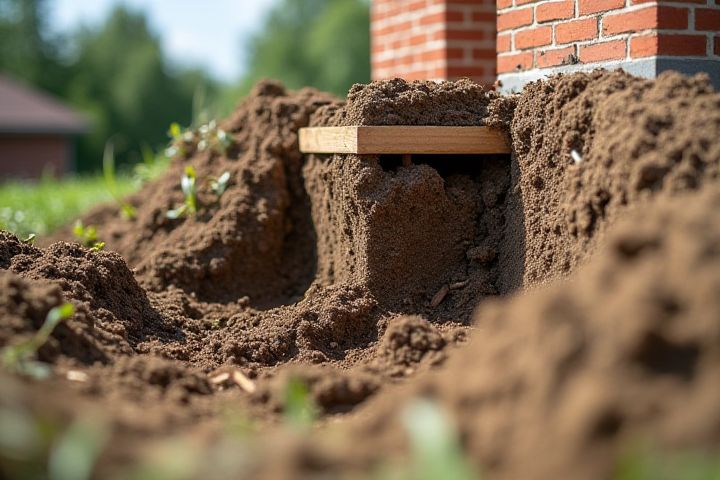
House foundations can fail due to various factors, including poor soil conditions, inadequate drainage, and moisture fluctuations. Expansive clay soils can expand when wet and shrink when dry, exerting pressure on the foundation and leading to cracks. Poor drainage systems can result in water pooling around the foundation, causing erosion and undermining the structural integrity. If the foundation was not designed to support the load of the structure, it can lead to uneven settling and eventual failure. Regular inspections and maintenance can help mitigate these risks and ensure your foundation remains stable over time.
Why House Foundations Fail
Poor soil conditions
Poor soil conditions significantly contribute to house foundation failure, primarily due to inadequate support for the structure above. Factors such as expansive clay, loose sandy soils, or overly wet conditions can lead to soil movement and settlement, compromising foundation stability. If the soil shrinks or swells with moisture changes, it can exert pressure on the foundation, causing cracks and misalignment. To safeguard your home, it is crucial to conduct a thorough soil analysis prior to building or making modifications to ensure it can adequately bear the weight of your foundation.
Inadequate drainage
Inadequate drainage around a house foundation can lead to significant moisture accumulation in the soil, causing increased hydrostatic pressure that can damage structural integrity. When water is not properly directed away from the foundation, it can infiltrate cracks and seams, resulting in soil erosion and settling. Excessive moisture contributes to the growth of mold and mildew, posing health risks and deteriorating building materials over time. To maintain a sturdy foundation, ensure proper grading and install effective drainage systems like French drains, gutter downspouts, and sump pumps to redirect water away from your home.
Substandard construction materials
Substandard construction materials severely compromise the integrity of house foundations, leading to structural failures. For instance, inadequate concrete mixes may lack essential strength, resulting in cracks that can widen over time, impacting the entire foundation. Furthermore, inferior steel reinforcement bars can corrode quickly, diminishing their load-bearing capacity along with the foundation's overall stability. In fact, using low-quality materials can shorten a foundation's lifespan dramatically, potentially by several decades, threatening both safety and property value.
Improper grading
Improper grading can lead to inadequate drainage around your house, causing water to pool near the foundation. This accumulation of water exerts pressure on the foundation walls, leading to cracks and potentially significant structural damage over time. Moreover, poor grading can cause soil erosion, which destabilizes the ground beneath the foundation, exacerbating the risk of shifting or settling. Regularly assessing and adjusting the grading around your property is vital to ensure proper runoff and maintain the integrity of your home's foundation.
Tree root intrusion
Tree root intrusion significantly contributes to house foundation failures by exerting pressure on the soil beneath a structure. As tree roots grow, they can penetrate cracks or weaknesses in the foundation, causing it to shift or settle unevenly. This intrusion often disturbs the soil moisture balance, leading to expansive soil conditions that further compromise the foundation integrity. Regular monitoring of nearby trees and maintaining adequate distance can help prevent costly structural damage to your home.
Plumbing leaks
Plumbing leaks can significantly compromise house foundations, often leading to costly repairs. Approximately 25% of foundation issues arise from water damage caused by undetected leaks, which can erode soil and alter the ground's stability. When leaks occur, water saturates the soil surrounding the foundation, leading to hydrostatic pressure that can force cracks and shifting. To protect your home, regular plumbing inspections and prompt repairs are crucial in preventing potential foundation damage and ensuring structural integrity.
Weather conditions
House foundations can fail due to extreme weather conditions, including heavy rainfall, drought, and temperature fluctuations. Prolonged rain can saturate the soil, leading to erosion and soil displacement, which undermines foundation stability. Conversely, drought causes soil shrinkage, creating voids that can result in cracking or settling of the foundation. As temperatures fluctuate, freeze-thaw cycles can exert pressure on foundation walls, causing damage or structural instability.
Groundwater pressure
House foundations can fail due to excessive groundwater pressure, which exerts force on foundation walls and footings. When groundwater levels rise, especially after heavy rainfall or snowmelt, the increased hydrostatic pressure can lead to cracks, shifting, or even complete failure of the foundation structure. Homes located in areas with high water tables or poor drainage systems are particularly vulnerable, as they may experience persistent moisture issues. You should regularly monitor your property's drainage and implement measures like proper grading or French drains to mitigate groundwater pressure effects on your foundation.
Settlement or shifting
House foundations often fail due to settlement or shifting, which occurs when the soil beneath a structure becomes unstable. Factors such as moisture variations, poor drainage, and soil composition can cause this instability, leading to uneven settling and cracks in walls. Over time, the weight of the structure can exacerbate these issues, resulting in significant structural damage that compromises safety. To mitigate foundation problems, it's crucial to monitor soil conditions and implement proper drainage solutions to enhance stability and prolong the integrity of your home.
Lack of maintenance
A lack of maintenance can significantly contribute to house foundation failure, with 25% of foundations experiencing issues due to neglected repairs and upkeep. Over time, cracks can develop in the foundation, often caused by soil erosion or water damage, which may escalate if not addressed promptly. Homeowners should pay attention to signs such as water pooling near the foundation, as ignoring these may lead to costly repairs that can exceed $10,000. Regular inspections and maintenance can enhance stability, extending the life of your foundation and protecting your investment.
